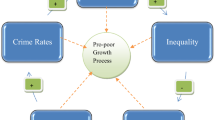Abstract
This paper measures the extent to whichrecent increasesin the aggregate povertyrate are attributable to the changing distribution of employment across industries. We decompose the total poverty rate change over the 1976-1983 period into components attributable to changesin employment sharesand changes in the incidence of poverty within industries. Our results show that the poverty rate increase resulted primarily fromthe decline in employment rates in general and from increases in the incidence of poverty within all industries, rather than from the shift of employment opportunities between sectors. The growth of service sector employment in particular has not contributed to the increased incidence of poverty in the United States.
Similar content being viewed by others
References
Anderson, W. H. L. 1964. “Trickling Down: The Relationship between Economic Growth and the Extent of Poverty among American Families.” Quarterly Journal of Economics 78(4): 511–24.
Bane, M. J. and D. T. Ellwood. 1986. “Slipping Into and Out of Poverty: The Dynamics of Spells.” Journal of Human Resources 21(1): 1–23.
Bawden, D. Lee. 1984. The Social Contract Revisited. Washington, D.C.: The Urban Institute, 157–177.
Beck, E.M., P. Horan and C. M. Tolbert, II. 1978. “Stratification in a Dual Economy: A Sectoral Model of Earnings Determination.” American Sociological Review 43: 704–720.
Blank, R. M. and A. S. Blinder. 1986. “Macroeconomics, Income Distribution, and Poverty.” pp. 180–208 in Fighting Poverty: What Works and What Doesn’t, edited by S. Danziger and D. Weinberg. Cambridge: Harvard University Press.
Bluestone, B. and B. Harrison. 1982. The Deindustrialization of America. New York: Basic Books, Inc.
Bradbury, K. L. 1986. “The Shrinking Middle Class.” New England Economic Review, September/October, pp. 41–55.
Bradbury, K. L.. 1990. “The Changing Fortunes of American Families in the 1980s.” New England Economic Review, July/August, pp. 25–40.
Corcoran, M. and M. S. Hill. 1980. “Unemployment and Poverty.” Social Service Review 54(3):407–13.
Council for Economic Opportunities in Greater Cleveland. 1987. Poverty Indicators/Trends, 1980-1987, Cuyahoga County, Ohio. Cleveland: Council for Economic Opportunities.
Danziger, S. H. and P. Gottschalk. 1985. “The Poverty of Losing Ground.” Challenge, May-June, pp.32-38.
— 1986a. “Do Rising Tides Lift All Boats? The Impact of Secular and Cyclical Changes on Poverty.” American Economic Review 76(2): 405–10.
—. 1986b. “Work, Poverty, and the Working Poor: A Multifaceted Problem.” Monthly Labor Review 109(9): 17–21.
Darity, W. A., Jr. and S. L. Myers, Jr. 1987. “Do Transfer Payments Keep the Poor in Poverty?” American Economic Review 77(2): 216–22.
Devens, R. M. 1987. “Industrial Structure and Jobless Rate of Experienced Workers.” Monthly Labor Review 110(5): 30–32.
Ellwood, D. T. and L. H. Summers. 1986. “Poverty in America: Is Welfare the Answer or the Problem?” pp. 78–105 in b, edited by. S. Danziger and D. Weinberg. Cambridge: Harvard University Press.
Gordus, J. P., P. Jarley and L. A. Ferman. 1981. Plant Closings and Economic Dislocation. Kalamazoo, Mi.: W. E. Upjohn Insitute for Employument Research.
Gottschalk, P. and S. Danziger. 1985. “A Framework for Evaluating the Effects of Economic Growth and Transfers on Poverty.” American Economic Review 75(1): 153–61.
Gramlich, E. M. and D. S. Laren. 1984. “How Widespread are Income Losses in a Recession?” pp. 157–73 in The Social Contract Revisited, edited by D. L. Bawden. Washington, DC: Urban Institute.
Gwartney, J. and T. S. McCaleb. 1985. “Have Antipoverty Programs Increased Poverty?” Cato Journal 5(1): 1–16.
Harrington, M. 1962. The Other America. New York: Macmillan.
Hirsch, B. T. 1985. “Poverty, Transfers, and Economic Growth.” Public Finance Quarterly 13(1): 81–98.
Hodson, R. 1983. Workers’Earnings and Corporate Economic Structure. New York: Academic Press.
—. 1986. “Modeling the Effects of Industrial Structure on Wages and Benefits.” Work and Occupations 13: 488–510.
Horvath, F. W. 1987. “The Pulse of Economic Change: Displaced Workers of 1981–85.” Monthly Labor Review 110(6): 3–9.
Lilien, D. 1982. “Sectoral Shifts and Cyclical Unemployment.” Journal of Political Economy 90: 777–93.
Mellor, E. F. 1987. “Workers at the Minimum Wage or Less: Who They Are and the Jobs They Hold.” Monthly Labor Review 110(7): 34–38.
Michel, R. c., F. S. Levy, M. L. Moon and I. V. Sawhill. 1984. “Are We Better Off in 1984?” Challenge, September-October, pp. 10–17.
Murray, C. A. 1984. Losing Ground. New York: Basic Books.
Neelin, J. 1987. “Sectoral Shifts and Canadian Unemployment.” Review ofEconomics and Statistics 64(4): 718–23.
O’Neill, J. A. 1986. “Transfers and Poverty: Cause and/or Effect?” Cato JournaI 6(1): 55–76.
Podgursky, M. and P. Swaim. 1987. “Duration of Joblessness Following Displacement.” Industrial Relations 26(3): 213–26.
Ruggles, P. and R. Williams. 1986. “Transitions In and Out of Poverty: New Data from the Survey of Income and Program Participation.” Presented at the annual meetings of the Allied Social Science Associations, New Orleans.
Ruhm, C. J. 1987. “The Extent and Persistence of Unemployment Following Permanent Quits and Layoffs.” Unpublished manuscript, Boston University.
Sehgal, E. 1985. “Employment Problems and Their Effect on Family Income, 1979–83.” Monthly Labor Review, 108(8): 42–43.
Singelmann, J. 1978. From Agriculture to Services: The Transformation of Industrial Employment. Beverly Hills, CA: Sage.
Smith, R. E. and B. Vavrichek. 1987. “The Minimum Wage: Its Relation to Incomes and Poverty.” Monthly Labor Review 110(6): 24–30.
Stone, C. F. and I. V. Sawhill. 1984. Economic Policy in the Reagan Years. Washington, DC: Urban Institute.
Thaler, R. H. 1989. “Anomalies: Interindustry Wage Differentials.” Journal of Economic Perspectives 3(2): 181–94.
U.S. Department of Commerce, Bureau of the Census. 1986. Money Income and Poverty Status of Families and Persons in the United States: 1985. Washington, DC: U.S. Government Printing Office.
Weinberg, D. H. 1986. “A Poverty Research Agenda for the Next Decade.” pp. 348–57 in Fighting Poverty: What Works and What Doesn’t, edited by S. Danziger and D. Weinberg. Cambridge: Harvard University Press.
Author information
Authors and Affiliations
Rights and permissions
About this article
Cite this article
Williams, D.R. Structural Change and the Aggregate Poverty Rate. Demography 28, 323–332 (1991). https://doi.org/10.2307/2061283
Issue Date:
DOI: https://doi.org/10.2307/2061283




